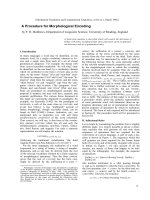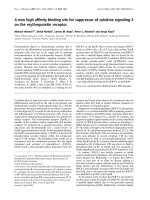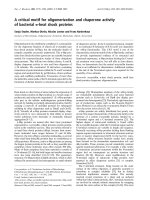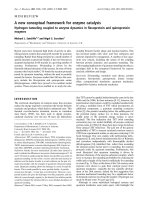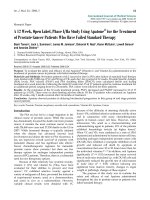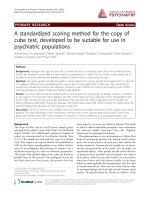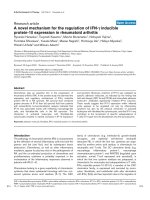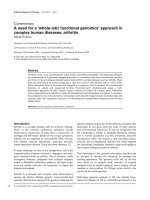Báo cáo y học: "A plea for balanced reporting" doc
Bạn đang xem bản rút gọn của tài liệu. Xem và tải ngay bản đầy đủ của tài liệu tại đây (110.8 KB, 2 trang )
I read with interest the study by Mayer and colleagues on
intraoperative hemodynamic optimization using Flotrac/
Vigileo [1]; however, the imbalance in their discussion
needs redressing. Citing a meta-analysis of esophageal
Doppler cardiac output (CO) validation studies that I co-
authored [2], they claimed this showed ‘limited accuracy’
and that ‘absolute CO measurements were found to be
imprecise’. Surprisingly, they made no mention of a
similar meta-analysis they published last year on the
FloTrac/Vigileo system [3] where the precision and bias
of the second generation device were no better!
Clearly, they wish to promote the device they use and
believe in, but it does no service to the medical and
scientifi c community to misrepresent one technology
over another. For example, they make no mention of the
limitations of the 12% pulse pressure variation value used
to predict fl uid responsiveness; with tidal volumes <8 ml/
kg, accuracy is only 51% [4] yet they did not report tidal
volumes delivered. Nor do they mention the inferior
results reported last year in an independent comparison
of the two devices undertaken for the French Agence
d’Evaluation des Produits de Sante [5].
ey did acknowledge an overall reduction of hospital
stay and complication rates in fi ve Doppler-directed
perioperative optimization studies (actually, nine such
studies are published to date). Is this not at odds with the
claimed ‘imprecision’? ey may be interested to learn of
a recent UK National Health Service Technology Adop-
tion Centre implementation project involving 1,247
surgical patients in 3 hospitals where these research
fi ndings could be reproduced in routine clinical practice,
with a 3-day reduction in hospital stay and fewer post-
operative complications [6]. I openly declare my aff ection
for the Doppler technology. It too has its imperfections
but the onus is on other monitoring devices to achieve
consistently similar - if not better - outcomes in
prospective randomized controlled trials. I conclude with
a general plea to advocates of any device or management
strategy to present a balanced view of advantages and
limitations, and to move away from partisan reporting.
e general knowledge base on CO monitoring devices is
woefully inadequate so it is incumbent upon the
afi cionado to educate properly.
© 2010 BioMed Central Ltd
A plea for balanced reporting
Mervyn Singer*
See related research by Mayer et al., />LETTER
*Correspondence:
University College London, Cruciform Building, Gower Street, London WC1E 6BT, UK
Authors’ response
Jochen Mayer, Joachim Boldt, Andinet Mengistu, Kerstin D Röhm and Stefan Suttner
We thank Dr Singer for his interest in our recently
published article [1]. We would like to address some of
the issues raised by Dr Singer. e purpose of our article
was to demonstrate that intraoperative hemo dynamic
optimization with the easy-to-use FloTrac/Vigileo device
results in an improved outcome. We did not disavow that
intraoperative optimization also works with other
techniques. e scope of our study had to be kept within
the limits of a research article and not all available
literature could therefore be mentioned or discussed.
Nevertheless, we tried to give a short overview of other
techniques and cited the peer-reviewed meta-analysis of
the esophagus Doppler method by Dark and Singer [2].
is publication states ‘signifi cant diff er ences in the
median percentage of clinical agreement’ between esopha-
gus Doppler and bolus pulmonary artery thermodilution.
e ability of the FloTrac to predict fl uid responsiveness
was shown by Hofer and colleagues [7]. Tidal volumes of
controlled mechanical ventilation were 8 ml/kg body-
weight or higher in all patients during the measurement
periods in our study.
Abbreviations
CO = cardiac output.
Competing interests
MS was heavily involved in the development of the CardioQ esophageal
Doppler monitor and performs consultancy work for Deltex Medical.
University College London is the bene ciary of unrestricted donations for
research and the University holds shares in Deltex Medical bequeathed by
the Pauline Thomas Charitable Trust. JM and JB received speaking fees from
Edwards Lifesciences, Irvine, CA, USA.
Published: 20 April 2010
Singer Critical Care 2010, 14:414
/>© 2010 BioMed Central Ltd
References
1. Mayer J, Boldt J, Mengistu AM, Röhm KD, Suttner S: Goal-directed
intraoperative therapy based on autocalibrated arterial pressure
waveform analysis reduces hospital stay in high-risk surgical patients:
arandomized, controlled trial. Crit Care 2010, 14:R18.
2. Dark PM, Singer M: The validity of trans-esophageal Doppler
ultrasonography as a measure of cardiac output in critically ill adults.
Intensive Care Med 2004, 30:2060-2066.
3. Mayer J, Boldt J, Poland R, Peterson A, Manecke GR Jr: Continuous arterial
pressure waveform–based cardiac output using the FloTrac/Vigileo:
areview and meta-analysis. J Cardiothor Vasc Anesth 2009, 23:401-406.
4. De Backer D, Heenen S, Piagnerelli M, Koch M, Vincent JL: Pulse pressure
variations to predict uid responsiveness: in uence of tidal volume.
Intensive Care Med 2005, 31:517-523.
5. Chatti R, De Rudniki S, Marqué S, Dumenil AS, Descorps-Declère A, Cariou A,
Duranteau J, Aout M, Vicaut E, Cholley BP: Comparison of two versions of
the Vigileo-FloTrac system (1.03 and 1.07) for stroke volume estimation:
amulticentre, blinded comparison with oesophageal Doppler
measurements. Br J Anaesth 2009, 102:463-469.
6. Doppler Guided Intraoperative Fluid Management [http://www.
technologyadoptionhub.nhs.uk/doppler-guided-intraoperative- uid-
management/executive-summary.html]
7. Hofer CK, Senn A, Weibel L, Zollinger A: Assessment of stroke volume
variation for prediction of uid responsiveness using the modi ed
FloTrac™ and PiCCOplus™ system. Crit Care 2008, 12:R82.
doi:10.1186/cc8942
Cite this article as: Singer M: A plea for balanced reporting. Critical Care
2010, 14:414.
Singer Critical Care 2010, 14:414
/>Page 2 of 2

